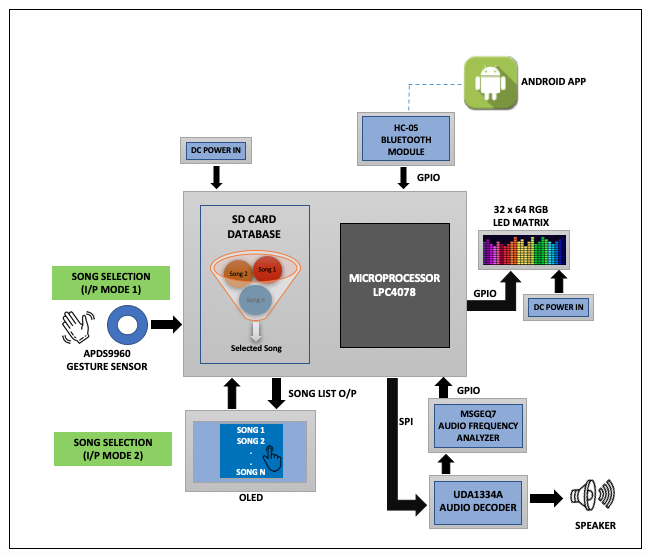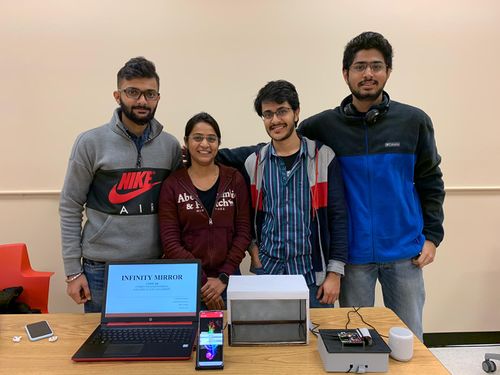F19: Infinity Mirror
Contents
- 1 Infinity Mirror
- 2 Abstact
- 3 Introduction & Objectives
- 4 Team Members & Technical Responsibilities
- 5 Administrative Responsibilities
- 6 Team Deliverables Schedule
- 7 Bill of Materials (General Parts)
- 8 Printed Circuit Board
- 9 Design & Implementation
- 10 Testing & Technical Challenges
- 11 Conclusion
- 12 References
Infinity Mirror
Abstact
In this project our main aim to build an embedded system based Music System that also displays 7 bands of frequency spectrum on an (32 x 64) LED display. The MP3 system plays music through a speaker interfaced with the board. It deals with the convergence of various services such as gesture recognition, audio decoding, audio saving and retrieving, mirroring visualisation etc. This project consists of ‘Audio Codec’ ‘RGB LED Matrix’ & 'HC-05' along with some other onboard features ‘Gesture detection’ ‘Ambient Light Sensing’ and ‘OLED Display’ with SJ-two Launch pad.
Introduction & Objectives
The key features support by the system are real-time Gesture recognition & trigger actions in player and display audio Spectrum on LED matrix:
1. Determine the actions of air gesture based on the input received or through a manual key selection of songs from the Songs List (In this prototype, search for the response for recognised gesture from the database & perform actions to other peripherals.)
2. In response, retrieve the data from the SD Card & communicate to the audio decoder for audio streaming.
3. Onboard display will show current playing song information and LED Matrix will show audio spectrum patterns using mirroring Visualisation effect.
4. Interacting with HC-05 bluetooth for communicating with Mobile App.
5. A Game related to Audio and Gesture detection - a ball smasher game in which ball will be randomly created on the LED matrix based on the Audio Frequency which will be smashed by collecting Gesture in that particular direction and display the score on the OLED Display.
Project Objectives
1. Audio Codec - Interacting with Audio Codec for getting the sound samples & generating sound signals from the device
2. Gesture Sensor - Detects the Hand Gesture and send the detected gesture to LED Matrix to navigate LED's.
3. SD Card - Audio data or mp3 files will be retrieved from the SD card based on the user selection.
4. Audio Decoder - Intelligently processing the audio data using audio decoder and sent to the LED Matrix to display spectrum patterns.
5. Bluetooth HC-05 - Interfaces the system using Bluetooth to an Android application.
Team Objectives
1. Learn each and every module as much as possible, in order to develop an overall product.
2. Understand the proper use of queues and semaphores in order to send/receive the data between multiple tasks.
3. Document and track all the bugs encountered during development and learn to update git repo after every fix.
Team Members & Technical Responsibilities
- Git Project Link: [1]
- Audio Encoder/Decoder
- ESP8266 Communication Bridge
- Interfacing of LED Matrix
- Interfacing of Gesture Sensors & SD Card
- Android & Web Application
- LCD Interfacing & UI Designing
- Hardware PCB Integration
- Testing
Administrative Responsibilities
| Administrative Roles | ||||
|---|---|---|---|---|
|
Aakash Chitroda | |||
|
Niket Naidu | |||
|
Vidushi Jain | |||
|
Vidushi Jain | |||
|
Ganesh Ram | |||
Team Deliverables Schedule
| WEEK |
START DATE |
END DATE |
TASK DETAILS |
STATUS |
|---|---|---|---|---|
| 1 | 15 Oct 2019 | 22 Oct 2019 |
|
Completed Completed Completed Completed |
| 2 | 23 Oct 2019 | 29 Oct 2019 |
|
Completed Completed Completed Completed Completed |
| 3 | 30 Oct 2019 | 5 Nov 2019 |
|
In Progress Completed In Progress In Progress Completed Completed |
| 4 | 6 Nov 2019 | 12 Nov 2019 |
|
|
| 5 | 13 Nov 2019 | 19 Nov 2019 |
|
|
| 6 | 20 Nov 2019 | 26 Nov 2019 |
|
|
| 8 | 27 Nov 2019 | 3 Dec 2019 |
|
|
| 9 | 4 Dec 2019 | 10 Dec 2019 |
|
|
| 10 | 11 Dec 2019 | 17 Dec 2019 |
|
|
| 11 | 18 Dec 2019 |
|
Bill of Materials (General Parts)
| PART NAME |
PART MODEL & SOURCE |
QUANTITY |
COST PER UNIT (USD) |
|---|---|---|---|
|
|
|
|
|
|
| |
|
|
| |
|
|
| |
|
|
| |
|
|
|
|
|
|
|
|
|
|
|
Printed Circuit Board
Design & Implementation
The design section can go over your hardware and software design. Organize this section using sub-sections that go over your design and implementation.
Hardware Design
Discuss your hardware design here. Show detailed schematics, and the interface here.
Hardware Interface
In this section, you can describe how your hardware communicates, such as which BUSes used. You can discuss your driver implementation here, such that the Software Design section is isolated to talk about high level workings rather than inner working of your project.
Software Design
Show your software design. For example, if you are designing an MP3 Player, show the tasks that you are using, and what they are doing at a high level. Do not show the details of the code. For example, do not show exact code, but you may show psuedocode and fragments of code. Keep in mind that you are showing DESIGN of your software, not the inner workings of it.
Implementation
This section includes implementation, but again, not the details, just the high level. For example, you can list the steps it takes to communicate over a sensor, or the steps needed to write a page of memory onto SPI Flash. You can include sub-sections for each of your component implementation.
Testing & Technical Challenges
Describe the challenges of your project. What advise would you give yourself or someone else if your project can be started from scratch again? Make a smooth transition to testing section and described what it took to test your project.
Include sub-sections that list out a problem and solution, such as:
Bug/issue name
Discuss the issue and resolution.
Conclusion
Conclude your project here. You can recap your testing and problems. You should address the "so what" part here to indicate what you ultimately learnt from this project. How has this project increased your knowledge?
Project Video
Upload a video of your project and post the link here.
Project Source Code
References
Acknowledgement
Any acknowledgement that you may wish to provide can be included here.
References Used
List any references used in project.
Appendix
You can list the references you used.

